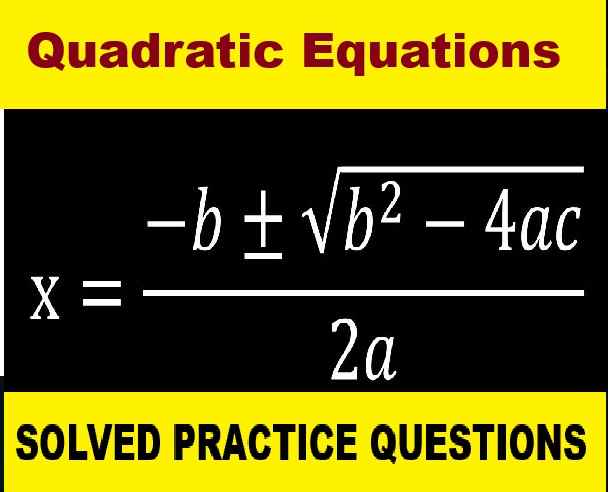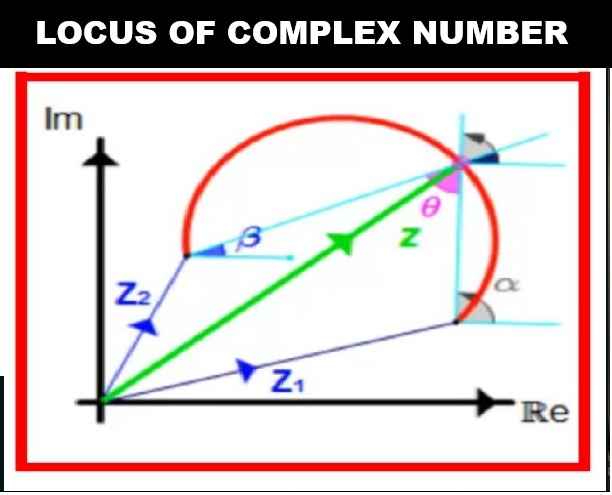Rectilinear Figures Class 9 OP Malhotra Exe-11A ICSE Maths Solutions Ch-11. We Provide Step by Step Solutions / Answer of Questions on Rectilinear Figures OP Malhotra Maths. Visit official Website CISCE for detail information about ICSE Board Class-9 Mathematics.
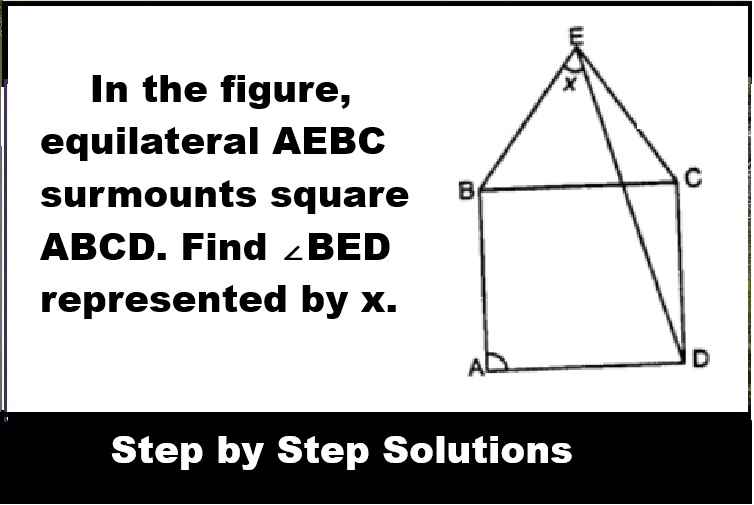
Rectilinear Figures Class 9 OP Malhotra Exe-11A ICSE Maths Solutions Ch-11
| Board | ICSE |
| Publications | S Chand |
| Subject | Maths |
| Class | 9th |
| Chapter-11 | Rectilinear Figures |
| Writer | OP Malhotra |
| Exe-11A | Solved Problems on Rectilinear Figures |
| Edition | 2025-2026 |
Exercise- 11A
Rectilinear Figures Class 9 OP Malhotra ICSE Maths Solutions Ch-11
Que-1: Calculate the angles marked with small letters in the diagrams drawn in the figures.

Sol: (i) ∵ In a rectangle, diagonals are equal and bisect each other at O
∴ AO = BO
∴ ∠OAB = ∠OBA = 18° (given)
But ∠ABC = 90° (Angles of a rectangle)
∴ x = 90° – 18° = 72°
(ii) In rectangle PQR.S, its diagonals bisects each other at T
∠PTQ = 120°.
∴ ∠TPQ + ∠TQP = 180°- 120° = 60°
But PT = QT
∴ ∠TPQ = ∠TQP = 60/2 = 30°
Now ∠SRT = ∠TPQ (alternate angles)
∴ b = 30°
But a + b = 90° (angles of a rectangle)
⇒ a + 30° = 90° ⇒ a = 90° – 30° = 60°
∴ a = 60°, b = 30°
(iii) In the rhombus EFGH,
∠EFG = 140°
But ∠EFG + ∠FGH = 180° (co-linear angles)
⇒ 140° +∠FGH = 180°
⇒ ∠FGH = 180°- 140° = 40°
∵ Diagonals of a rhombus bisects the angles
∴ x = (1/2) x 40° = 20°
(iv) ∵ The diagonaLs of a rhombus bisect each-other at right angles
∴ ∠PLQ = 90°
Now in ∆PLQ
∴ ∠LPQ + ∠LQP = 90°
⇒ 34° + x = 90° ⇒ x = 90° – 34°
x = 560
∵ Diagonal QS bisects ∠Q and ∠S
∴ x = y ⇒ y = 56°
Hence x = 56°, y = 560
(v) In the square ABCD,
Diagonal AC intersects a line DY such that
DY such that
∠DXC = 112°
∵ Diagonal AC bisects the angles A and C
∴ ∠ACB on ∠XCY = 45°
But ∠CXY + ∠CXD = 180°
(Linear pair)
∴ ∠CXY + 112°= 180°
⇒ ∠CXY = 180° – 112° = 68°
Now in ∆CXY,
∠CXY + ∠XYC + ∠XCY = 180°
⇒ 68° + d + 45° = 180°
⇒ 113° + d = 180°
⇒ d = 180° – 113°
⇒ d = 67°
∴ d = 67°
(vi) In square CDEF,
DF is its diagonal
EN is a line segment which intersects DF at M such that ∠EMF = 38°, ∠MNC = x
∵ ∠EMF = ∠DMN
(vertically opposite angles)
∴ DMN = 38°
But diagonal DF bisects the ∠D and ∠F
∴ ∠MDN = 45°
In ∆MND,
Ext. ∠MNC = ∠DMN + ∠MDN
⇒ x = 38° + 45° = 83°
Hence x= 83°
(vii) In the figure,
AB || DC and AD = BC
∠A = a,∠C = 75°
∵ ABCD is an isosceles trapezium
∴ ∠A + ∠C = 180° and ∠B + ∠D = 180°
Now∠A + ∠C = 180°
⇒ a + 75° = 180° ⇒ a = 180° – 75°
∴ a = 105°
(viii) The figure is of a kite whose diagonals AC and BD are perpendicular to each other.
AB = AD and CB = CD
Now, in right ∠OCD, ∠DOC = 90°
∴ a + 39° = 90° ⇒ a = 90° – 39° = 51°
In ∆ABD, AB = AD
∴ ∠ADO = ∠ABO = 90°
and in right ∆AOD, ∠AOD = 90°
∴ b + ∠ADO = 90°
⇒ b + 74° = 90°
∴ b = 90° – 74° = 16°
(ix) ABCD is an isosceles trapezium in which AB || DC
AD = BD and diagonals
AC and BD intersect each other at O
∠ODC = ∠OCD = 34°
(ix) ABCD is an isosceles trapezium in which AB || DC
AD = BD and diagonals
AC and BD intersect each other at O
∠ODC = ∠OCD = 34°
But in ∆OCD,
a + ∠ODC + ∠OCD = 180°
a + 34° + 34° = 180° ⇒ a + 68° = 180°
∴ a = 180° – 68° = 112°
and ∠ADB = ∠ACB = b
∴ ∆OBC
Ext. a = 12° + b
⇒ 112° = 72 ° + b
⇒ b = 112° – 72° = 40°
Hence ∠A = 112° and ∠B = 40°
Que-2: Find each angle of a parallelogram if two consecutive angles are in the ratio of 1 : 5.
Sol: In parallelogram ABCD,
∠A : ∠B = 1 : 5
Let ∠A = x, then ∠B = 5x
But ∠A + ∠B = 180° (co-interior angles)
∴ x + 5x – 180° ⇒ 6x = 180°
⇒ x = 180/6 = 30°
∴ ∠A = 30°, ∠B = 5x = 5 x 30° = 150°
and ∠C = ∠A = 30 and ∠D = ∠B = 150°
Que-3: Find the size of the angles of a parallelogram if one angle is 20 less than twice the smallest angle.
Sol: Let the smallest angle = x
Then other greatest angles = 2x – 20
But x + 2x – 20 = 180°
3x – 20 = 180 ⇒ 3x = 180 + 20 = 200
∴ x = 200/3 = 66*(2/3)
∴ Smallest angle = 66*(2/3)°
and greater angle = 2x – 20
= 2 x (200/3) – 20
= (400/3) – 20 = (400−60)/3
= 340/3 = 113*(1/3)°
∴ The angles of parallelogram are
66*(2/3)°, 113*(1/3)°, 66*(2/3)° and 113*(1/3)°
Que-4: If an angle of rhombus is 50°, find the size of the angles of one of the triangles which are formed by the diagonals.
Sol: ABCD is a rhombus in which ∠A = 50° and its diagonals AC and BD bisect each-other at O right angles
∴ ∠AOB = 90°
∵ Diagonals bisect the opposite angles 50°
∠OAB = 50°/2 = 25°
∠OBA = 180° = (90° + 25°)
= 180°- 115° = 65°
Hence angles are 25°, 65° and 90°.
Que-5:The diagonals AC and BD of a rectangle ABCD intersect each other at P. If ∠ABD = 50°, find ∠DPC.
Sol: In rectangle ABCD, diagonals AC and BD bisect each other at P
∠ABD = 50°
In ∆APB,
AP = BP
(∵ The diagonals bisect eachother)
∴ ∠PAB = ∠PBA or ∠ABD = 50°
∴ ∠APB = 180° – (50 + 50°)
= 180°- 100° = 80°
But ∠CPD = ∠APB
(vertically opposite angles)
∴ ∠CPD = 80°
Que-6: If an angle of parallelogram is two-third its adjacent angle, find the angles of the parallelogram.
Sol: In parallelogram ABCD
Let x and y be the two angles of a parallelogram.
It is given that one angle is two-third of its adjacent angle. So, we assume that angle “x” is two-third of angle “y” .
which is written as,
x = (2/3). y …….. (1)
We also know that the adjacent sides of a parallelogram are supplementary. It means that the sum of adjacent angles is equal to 180.
Hence, x + y = 180 …….. (2)
Put the value of x from equation (1) in equation (2):
(2/3) y + y = 180
(2/3 +1) y = 180
(5/3) y = 180
y = 180. (3/5)
y = 108
Now put this value in equation (2) to get the value of x:
x + 108 = 180
x = 180 – 108
x = 72
Hence, the adjacent angles of a parallelogram are 72° and 108° .
Que-7: In the figure, ABCD is a parallelogram in which ∠DAB = 70°, ∠DBC = 80°. Calculate angles CDB and ADB.

Sol: In parallelogram ABCD,
BD is its diagonal
∠DAB = 70°, ∠DBC = 80°
∠CDB = x and ∠ADB = y
∵ AD || BC and BD is its transversal
∠ADB = ∠DBC (alternate angles)
⇒ y = 80°
In ∆ABD,
∠DAB + ∠ABD + ∠ADB = 180°
(sum of angles of a triangle)
⇒ 70° + ∠ABD + 80°= 180°
⇒ 150° + ∠ABD = 180°
⇒ ∠ABD = 180° – 150° = 30°
But ∠CDB = ∠ABD (alternate angles)
⇒ x = 30°
Hence ∠ABD = 30° and ∠ADB = 80°
Que-8: Calculate the side of a rhombus if its diagonals are 18 cm and 24 cm respectively.
Sol: In a rhombus ABCD, diagonals AC = 24 cm, and BD = 18 cm

The diagonals of a rhombus bisect each other at right angles
∴ AO = OC = 24/2 = 12 cm
BO = OD = 18/2 = 9 cm
and ∠AOB = 90°
∴ In right ∆AOB
AB² = AO² + BO² (Pythagoras Theorem)
= (12)² + (9)²
= 144 + 81 = 225
= (15)²
∴ AB = 15
∴ Each side of rhombus ABCD = 15 cm
Que-9: The sides of a rhombus are 5 cm and one diagonal is 8 cm. Calculate (i) the length of the other diagonal and (ii) the area of the rhombus.
Sol: In rhombus ABCD,
AC and BD are its diagonals AB = 5 cm and AC = 8 cm
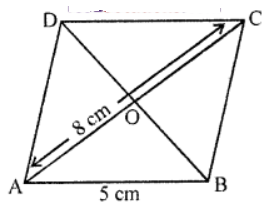
The diagonals of a rhombus bisect each other at right angles
∴ AO = OC = 8/2 = 4 cm and BO = OD and
∠AOB = 90°
Now in right ∆AOB
AB² = AO² + BO² (Pythagoras Theorem)
⇒ (5)² = (4)² + BO²
⇒ 25 = 16 + BO²
⇒ BO² = 25 – 16 = 9
⇒ BO² = 9 = (3)²
∴ BO = 3
∴ BD = 2BO = 2 x 3 = 6 cm
Now area of rhombus
= Product of diagonals / 2
(AC×BD)/2 = (8×6)/2
= 24 cm²
Que-10: PQRS is a rhombus :
(i) If it is given that PQ = 3 cm, calculate the perimeter of PQRS.
(ii) If the height of the rhombus is 2.5 cm, calculate the area.
(iii) If the diagonals cut at O, state the size of the angle POQ in degrees.
Sol: In rhombus ABCD
Side PQ = 3 cm
Height RL = 2.5 cm
and diagonals AC and BD cut each other at O

(i) Perimeter = 4 x side
= 4 x 3 cm = 12 cm
(ii) Base PQ = 3 cm and height RL = 2.5 cm
∴ Area of PQRS = Base x Height
= 3 x 2.5 = 7.5 cm²
(iii) The diagonals of a rhombus bisect each- other at right angles
∴ ∠POQ = 90°
Que-11: ABCD is a trapezium with AB parallel to DC. If AB = 10 cm, AD = BC = 4 cm and ∠DAB = ∠CBA = 60°, calculate
(i) the length of CD;
(ii) the distance between AB and CD.
Sol: ABCD is a trapezium in which AB = 10 cm, AD = 4 cm
∠DAB = ∠CBA = 60°

Draw CL ⊥ AB and DM ⊥ AB
∵ ∠DAB = ∠CBA (each = 90°)
∴ ABCD is an isosceles trapezium
AD = BC = 4 cm
In right ∆ADM,
=> Sin60 = DM/AD
=> √3 / 2 = DM/4
=> DM = 4√3 /2
=> DM = 2√3
the distance between AB and CD = 2√3
Cos 60 = AM/AD
=> 1/2 = AM/4
=> AM = 2
Similarly CN ⊥ AB
=> BN = 2
CD = AB – (AM + BN)
=> CD = 10 – (2 + 2)
=> CD = 6
Hence
(i) CD = 6 cm
(ii) Distance between AB and CD = 2√3 cm
Que-12: Find the value of y so that EFGH is isosceles.
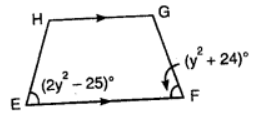
Sol: EFGH is an isosceles trapezium
∴ EH = FG
and ∠HEF = ∠GFE
⇒ 2y² – 25 = y² + 24°
2y² – y² = 24 + 25
⇒ y² = 49 = (±7)²
∴ y = 7 or – 7
Que-13: PQRS is a rhombus in which the diagonal PR is produced to T. If ∠SRT = 152°, then find x, y and z.
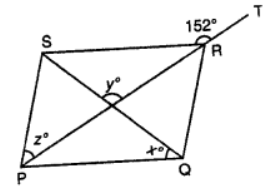
Sol: In rhombus PQRS, PR and QS are the diagonals which intersect each other at O
PR is produced to T
∠SRT = 152°
∵ ∠PRS + ∠SRT = 180° (Linear pair)
⇒ ∠PRS + 152°= 180°
⇒ ∠PRS = 180°- 152° = 28°
∴ ∠SPQ = ∠SRQ = 2∠PRS
= 2 x 28° = 56°
(∵ Diagonals of a rhombus bisect the angles)
But ∠PQR + ∠SRQ = 180°
(co-interior angles)
⇒ ∠PQR + 56°= 180°
⇒ ∠PQR = 180° – 56° = 124°
∴ x = (1/2) ∠PQR = (1/2) x 124° = 62°
∴ x = 62°
y = 90°
(∵ Diagonals of rhombus bisect each other at right angles)
z = ∠PRS = 28°
Que-14: In the figure, ABCD is a rhombus and ABE is an equilateral triangle ∠BCD = 78°. Calculate ∠ADE, ∠BDE and ∠BED.
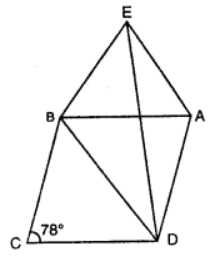
Sol: ABCD is a rhombus and ∆ABE is an equilateral triangle
BD and DE are joined ∠BCD = 78°
∠BAD = ∠BCD = 78°
and ∠EAB = 60°
(angle of equilateral triangle)
∠EAD = 78° + 60° = 138°
But in ∆EAD
AE = AD (given)
∴ ∠AED = ∠ADE
But ∠AED + ∠ADE + ∠EAD = 180° (angles of a triangle)
⇒ ∠ADE + ∠ADE + 138° = 180°
⇒ 2∠ADE = 180° – 138° = 42°
(i) ∴ ∠ADE = 42/2 = 21°
(ii) ∠AED = 60°
∴ ∠BED = ∠AEB – ∠AED = 60° – 21° = 39°
(iii) ∠BCD + ∠CDA = 180° (co-interior angles)
∴ ∠CDA = 180° – ∠BCD = 180° – 78° = 102°
BD is the diagonal of rhombus
∴ ∠BDA = (1/2) ∠CDA = (1/2) x 102° = 51°
But ∠ADE = 21°
∴ ∠BDE = 51° – 21° = 30°
Hence ∠ADE = 21°, ∠BDE = 30° and ∠BED = 39°
Que-15: In the figure, equilateral AEBC surmounts square ABCD. Find ∠BED represented by x.
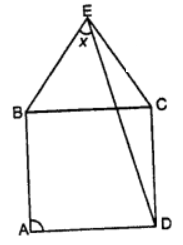
Sol: ABCD is a square and EBC is an equilateral triangle on BC
ED is joined
In ∆ECD,
CD = CE (given)
∠CED = ∠CDE
∴ (angles opposite to equal sides)
But ∠DCE = ∠DCB + ∠BCE
= 90° + 60° = 150°
∴ ∠CED + ∠CDE = 180° – 150° = 30°
⇒ ∠CED + ∠CED = 30°
⇒ 2∠CED = 30°
⇒ ∠CED = 30°/2 = 15°
But ∠BEC = 60°
(angle of an equilateral triangle)
∴ ∠BED = ∠BEC – ∠CED = 60°- 15° = 45°
Que-16: ABCD is a square. ABO is an equilateral triangle inside the square. Find ∠DOC.
Sol: ABCD is a square
∴ Its each angle = 90°
ABO is an equilateral triangle
Now in ∆OAD,
∠OAD = ∠BAD – ∠OAB = 90° – 60° = 30°
∴ ∠AOD + ∠ADO = 180° – 30° = 150°
But ∠AOD = ∠ADO (∵ OA = DA)
∴ ∠AOD = ∠ADO = 150°/2 = 75°
Similarly in ∆OBC,
∠BOC = 75°
But ∠DOC + ∠AOD + ∠BOC + ∠AOB
= 360° (Angles at a point)
⇒ ∠DOC + 75° + 75° + 60° = 360°
⇒ ∠DOC+ 210° = 360°
⇒ ∠DOC = 360° – 210° = 150°
Hence ∠DOC = 150°
— : End of Rectilinear Figures Class 9 OP Malhotra Exe-11A ICSE Maths Solutions Ch-11 :–
Return to :– OP Malhotra S Chand Solutions for ICSE Class-9 Maths
Thanks
Please Share with Your Friends
